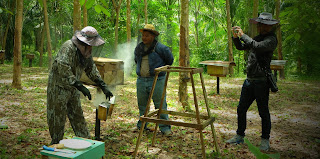MAP-Asia: Sweet Connections
 |
| Sean (Right) dressed to protect against stings |
By Maria Savage, MAP-Asia Intern. Photos by Jon Baines
IUCN Thailand has brought the Marriott Hotel chain Thailand, and Mangrove Action Project together to work on mangrove planting
projects in 2015.The Marriott Hotel relies on MAP’s knowledge for successful
planning of their restoration sites. On July 11th, 2016 a new
partnership opportunity arose when Mr. Sean Panton, CSR Marriott Representative and
Ms. Kanokwan Homchaaim (Nok) took a visit to Nai Nang Village, Krabi province.
projects in 2015.The Marriott Hotel relies on MAP’s knowledge for successful
planning of their restoration sites. On July 11th, 2016 a new
partnership opportunity arose when Mr. Sean Panton, CSR Marriott Representative and
Ms. Kanokwan Homchaaim (Nok) took a visit to Nai Nang Village, Krabi province.
 |
| Nai Nang villager happily surrounded by bees |
Producing honey could prove a long-term, supplementary
livelihood for the Nai Nang Village Apiculture Cooperative. In addition to this, honeybees help to pollinate
local plant species and will benefit the mangrove forest near by. The bees
pollinate flowering plants through the collection of nectar. The nectar is
taken back to the hive and is converted to honey through a process of
evaporation. The now viscous honey is contained in honeycombs to feed the busy
hive. The bees benefit from the mangroves because they produce flowers throughout the whole year.
livelihood for the Nai Nang Village Apiculture Cooperative. In addition to this, honeybees help to pollinate
local plant species and will benefit the mangrove forest near by. The bees
pollinate flowering plants through the collection of nectar. The nectar is
taken back to the hive and is converted to honey through a process of
evaporation. The now viscous honey is contained in honeycombs to feed the busy
hive. The bees benefit from the mangroves because they produce flowers throughout the whole year.
The honey is organic,
unpasteurized and delicious! Honey varies in taste and aroma depending on
the type of flower the bees is visiting. Nai Nang Honey has floral notes with
hints of sea salt credited to the mangrove flowers. Honey is well known for its
antibacterial, healing properties. MAP hopes this new marketing partner
will provide opportunities for the local community members to share the benefits of honey through supplementary livelihoods with 10% of income going directly to conservation activities.
unpasteurized and delicious! Honey varies in taste and aroma depending on
the type of flower the bees is visiting. Nai Nang Honey has floral notes with
hints of sea salt credited to the mangrove flowers. Honey is well known for its
antibacterial, healing properties. MAP hopes this new marketing partner
will provide opportunities for the local community members to share the benefits of honey through supplementary livelihoods with 10% of income going directly to conservation activities.
Sean was enthusiastic about featuring the Nai Nang
Honey on the hotel’s breakfast buffet. He plans to showcase the bottles with
background information about the village. This is an exciting new marketing
opportunity and could mean long-term support for the locals at Nai Nang Village.
Honey on the hotel’s breakfast buffet. He plans to showcase the bottles with
background information about the village. This is an exciting new marketing
opportunity and could mean long-term support for the locals at Nai Nang Village.
 |
| Nai Nang soap and honey |
 |
| Fresh Honeycomb |
Mangrove Apiculture information is available here:
https://mangroveactionproject.org/wp-content/uploads/2013/08/MAP-Mangrove-Apiculture-Info.pdf
